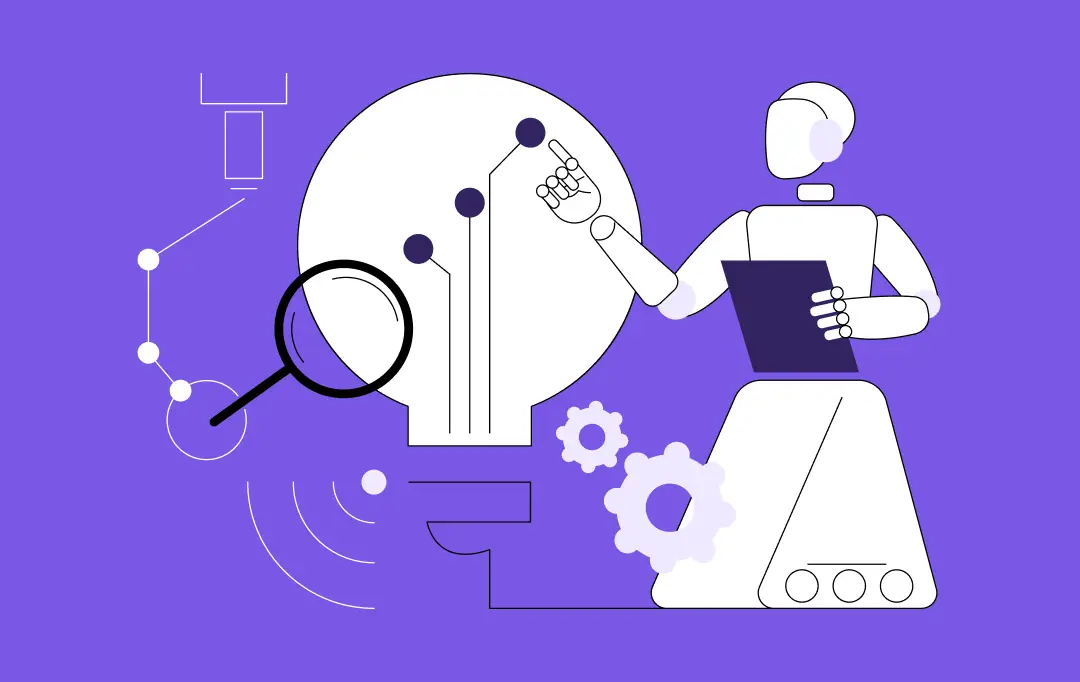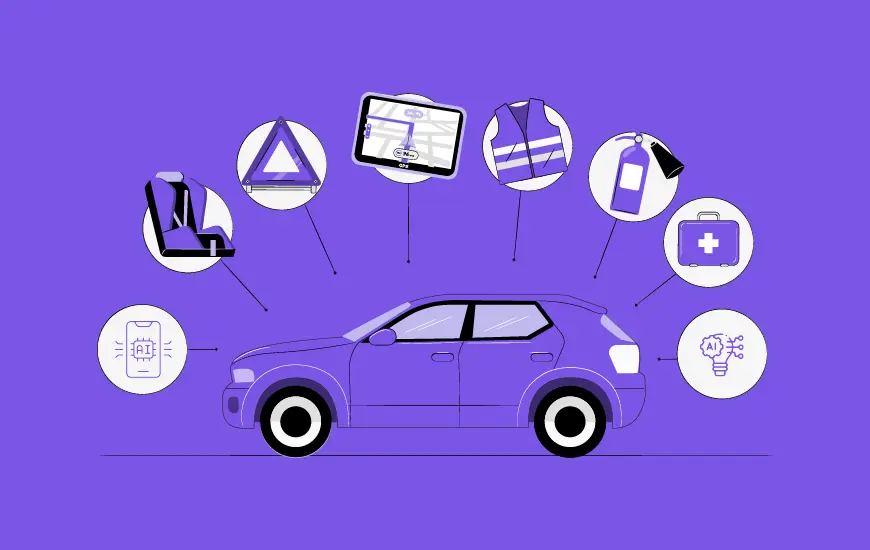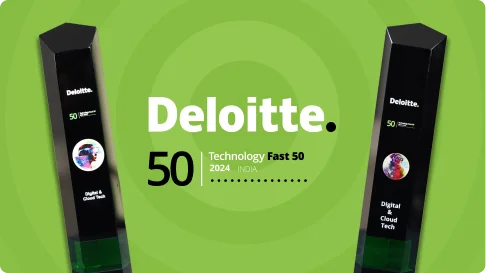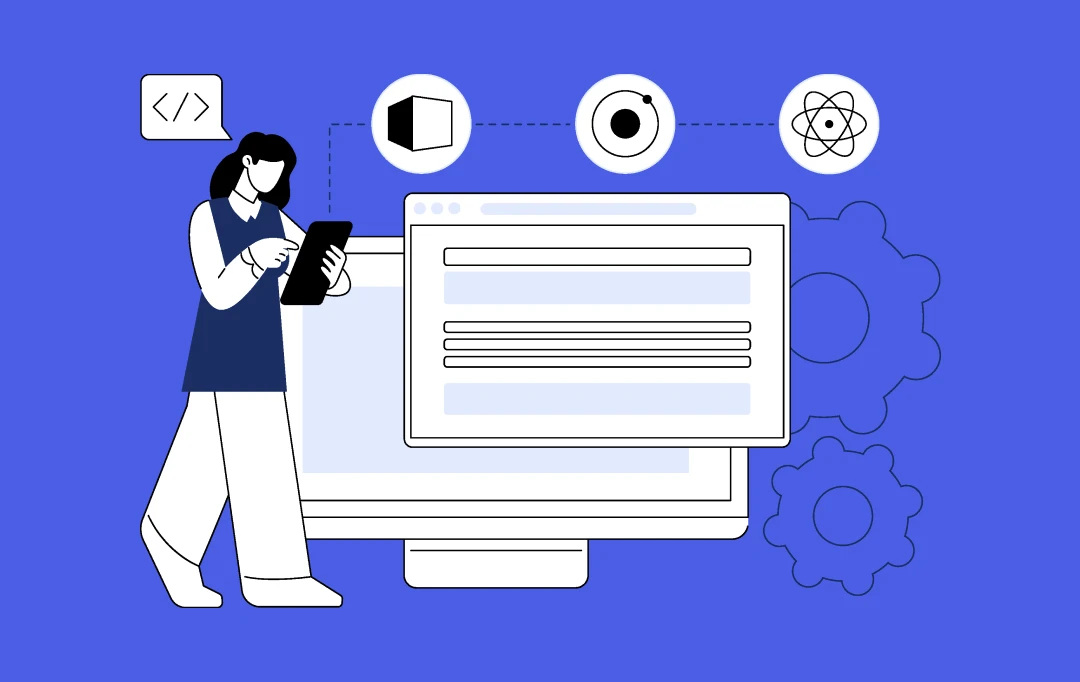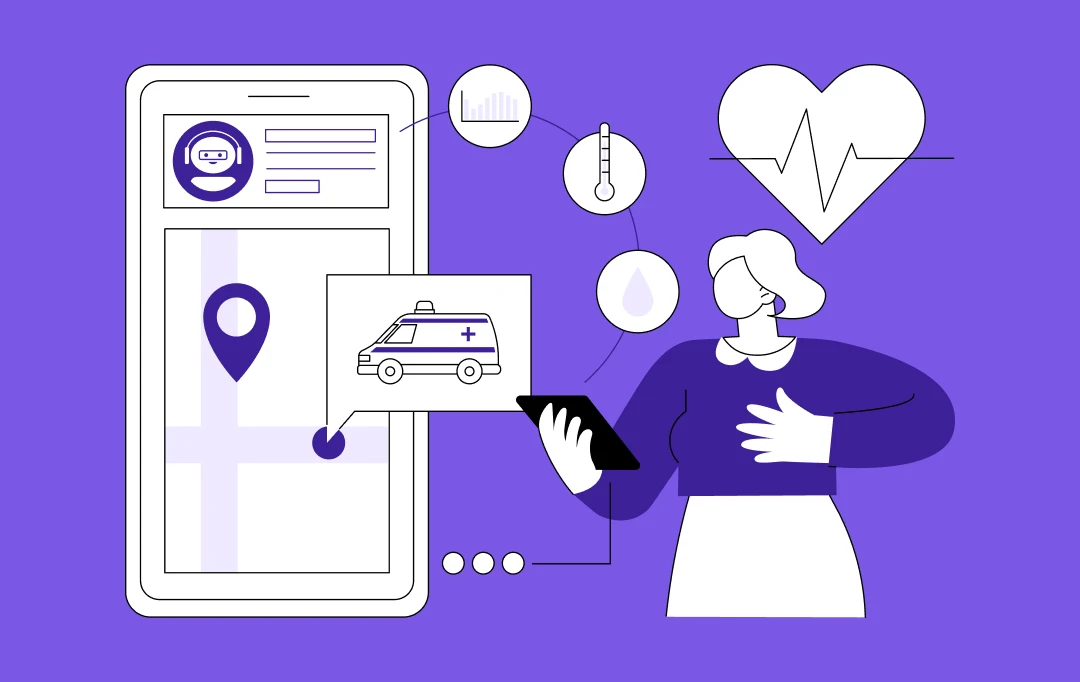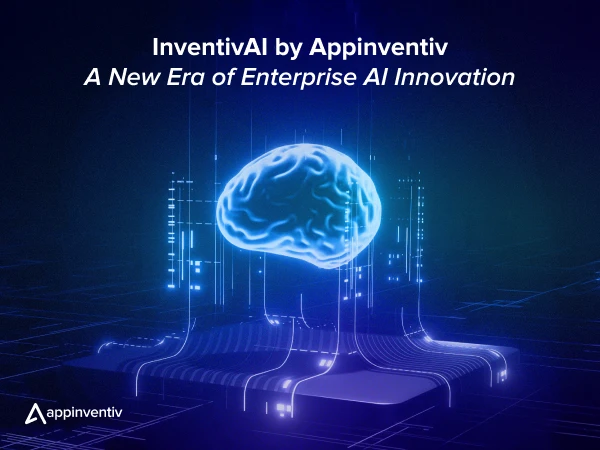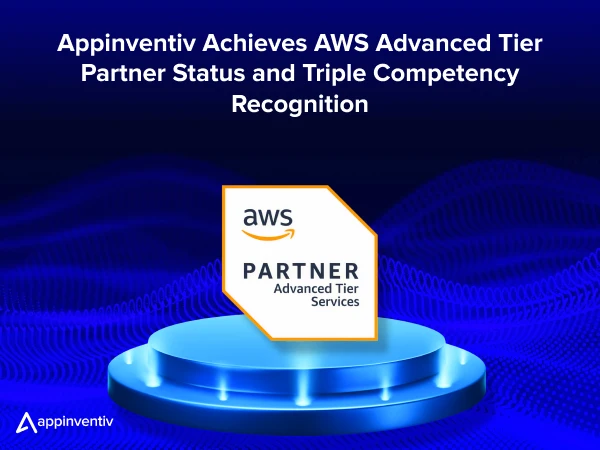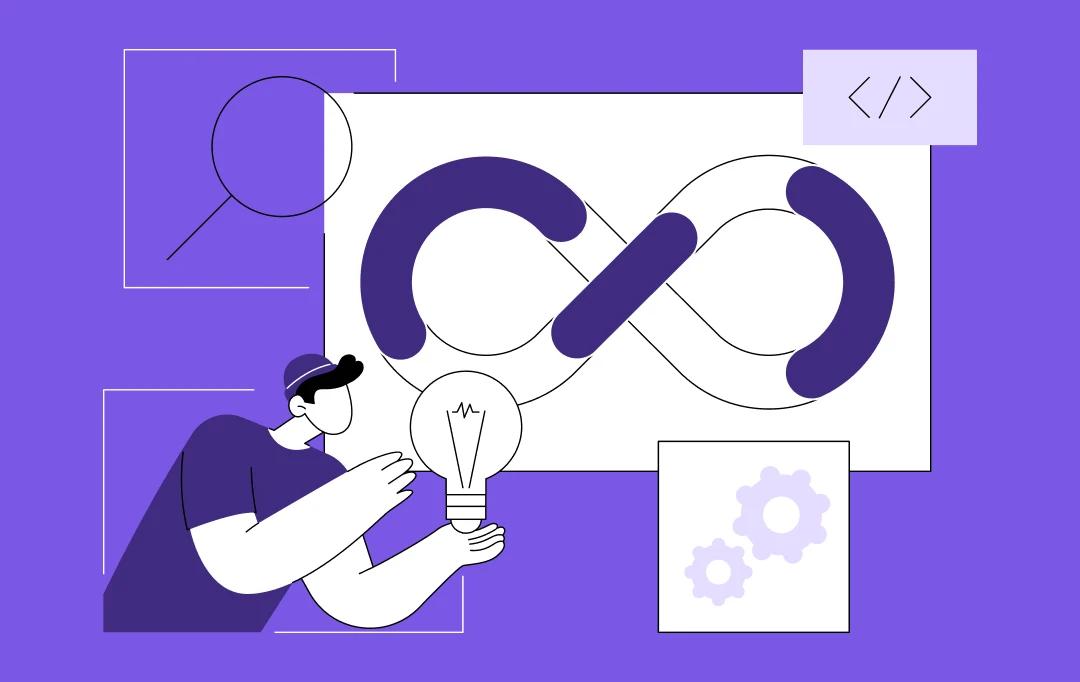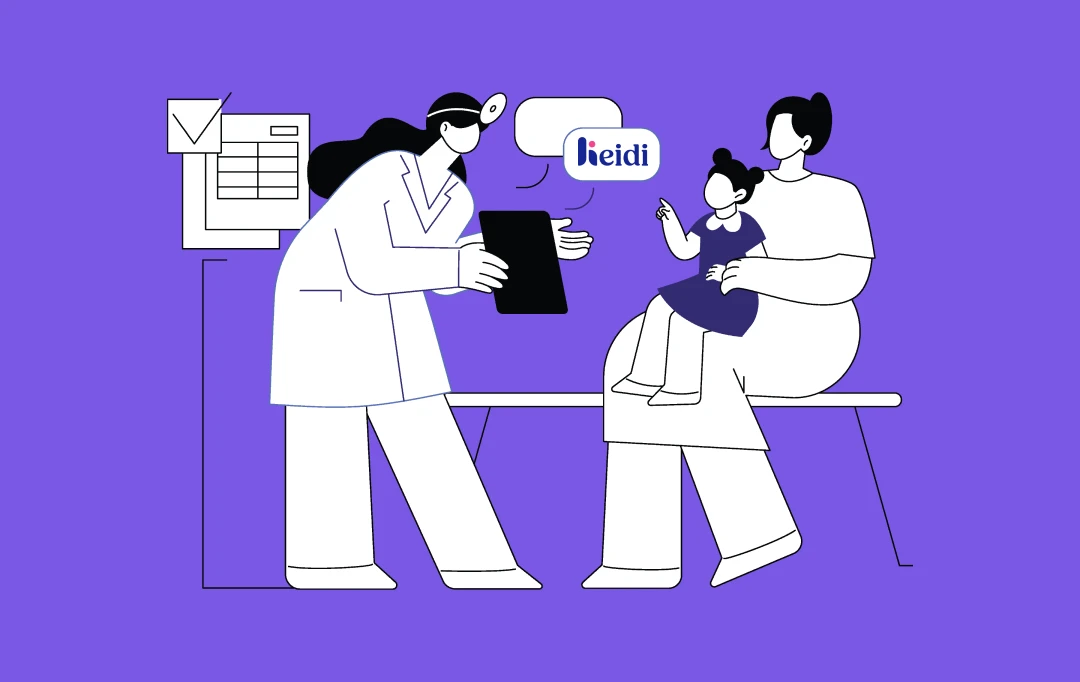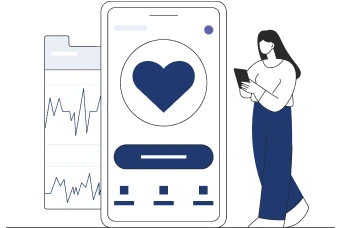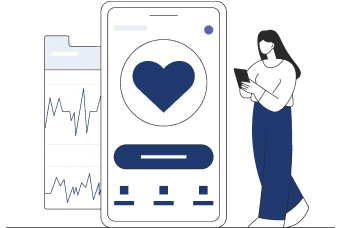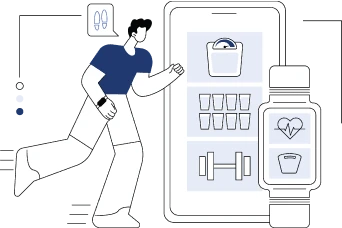- Deconstructing the AI Medical Scribe - Heidi Health: Core Functionality and Takeaways
- System Capabilities Which Have Made It Reputable in Australia
- Key Takeaways from Heidi Health for Businesses Seeking to Make an AI Medical Scribe in Australia
- Cost to Build an AI Medical Scribe in Australia
- Cost Estimates (Based on App Complexity)
- Cost Estimation (Based on Development Phase)
- Cost Estimation (Based on Features)
- Cost Estimation (Based on Compliance & Legal Expenses)
- Factors Affecting the Cost to Develop an AI Medical Scribe like Heidi Health in Australia
- Design Complexity:
- Backend Development:
- Backend Technology Stacks
- Third-Party Integrations
- Security and Compliance
- Platform Selection
- Advanced Technologies
- Feature Complexity
- Process to Develop AI Medical Scribe in Australia
- Discovery & Feasibility study
- UI/UX Design and Creating a Prototype
- Data preparation and model development of AI
- Backend Development Frontend Development
- Integration & Interoperability
- Quality Assurance
- Deployment and Authorization
- Release Support and Post-Launch Support and improvement
- Cost Optimization Strategies
- Minimum Viable Product (MVP) Strategy
- The Open-Source Tools and APIs Approach
- Agile Development Methodology
- Optimal Strategic Cloud Resource
- Hybrid and Outsourcing Models of Development
- AI features for Medical Scribe Apps for Australian Clinics/Hospitals that Out-Do Competitors
- Impeccable Predictive Analytics and Diagnostic Insight
- Effective Patient Energizing and Learning
- Automation in Increased Interoperability Workflow
- Multimodal AI Contextual Understanding
- Clinical Coding & Clinical Billing Optimization in real-time
- Appinventiv: Your Proven Partner for AI Medical Scribe Innovation in Australia
- FAQs
Key takeaways:
- AI Medical Scribes automate clinical note-taking, reducing administrative burdens and allowing clinicians to focus on patient care.
- Features like real-time transcription, customizable templates, and EHR integration improve workflow and save time.
- Adherence to Australian Privacy Principles and HIPAA ensures secure handling of sensitive patient data.
- Development costs range from AUD 68,700 to AUD 458,000, depending on complexity, features, and integrations.
- Advanced features like predictive analytics, multilingual support, and real-time billing optimization set modern AI scribes apart.
Medical documentation, which is quite important, has now become a silent battle that medical experts must endure, apparently at the expense of their patients’ constant outcry. Physicians and healthcare providers must use their valuable hours to carefully revise and edit notes, rather than resting to prepare for the next challenging shift.
This is a systemic problem that runs deep across several painful areas. They are continually struggling with documentation flaws and quality issues, as poor transcriptions of notes by the scribe can lead to misdiagnosis, improper treatment, or billing nightmares. Complex medical terminologies are often misinterpreted by generic solutions or less experienced human scribes, rendering the supposed efficiency gain a liability and creating the following repercussions: documentation errors and quality concerns, workflow integration issues, technical and communication problems, and so on.
These are not mere nuisances but rather stand in as a huge hindrance to the efficient, high-quality care of the patients and are one of the causes of the increasingly rampant provider burnout epidemic. However, what can be done to ease all these burdens and enable healthcare professionals to do what they do best: healing?
This is where the AI Medical Scribe enters the picture as a technological marvel that will revolutionize medical documentation. AI Medical Scribe offerings, including Heidi Health, are highly developed AI-powered Healthcare solutions in Australia that not only transcribe but also understand the entirety of the clinical recording. They can easily integrate into the workflow without interruption, thereby maintaining accuracy and protecting patient privacy in every situation with the utmost precision.
The question is now more relevant: how much does it cost to establish an AI Medical Scribe similar to Heidi Health in Australia, given its potential to change the environment?
The cost to develop an AI medical scribe like Heidi Health in Australia ranges from AUD 68,700 to AUD 458,000. This broad cost spectrum highlights the profound influence of desired features and project scope on the total expenditure.
Get an AI Medical Scribe to save time and boost accuracy.
Deconstructing the AI Medical Scribe – Heidi Health: Core Functionality and Takeaways
Heidi Health is an AI-based medical scribe application that sheds some light on the potential and strategic moves to make to simplify clinical documentation for healthcare professionals. It utilizes the power of artificial intelligence to detect conversations between patients and healthcare providers, creating accurate medical records that are then fed into Electronic Health Record (EHR) systems.
- The platform is designed to minimize the time spent on administrative tasks, allowing more clinicians to focus on direct patient care.
- Heidi Health offers a tiered pricing structure, including a free, unlimited, and permanent plan with unlimited consultations and dictation, as well as paid plans (Pro and Together) that unlock additional features.
System Capabilities Which Have Made It Reputable in Australia
Heidi Health’s primary functions include automated progress notes, session analytics, customizable note creation, medical dictation, and medical translation.
- This HIPAA-compliant App works with high security levels of patient data.
- Although its EHR integration is currently only one-way, with a primary pull of patient appointment information to help generate notes, its ease of use and improvement of efficiency have also aided its usage.
- Nurse clinicians who have used such a tool report feeling closer to patients and paying more attention to what they say and listen to as opposed to taking notes. The fact that reports can be generated and emailed to patients while they are out of the room, and that patients can receive encrypted email summaries, enhances communication and efficiency.
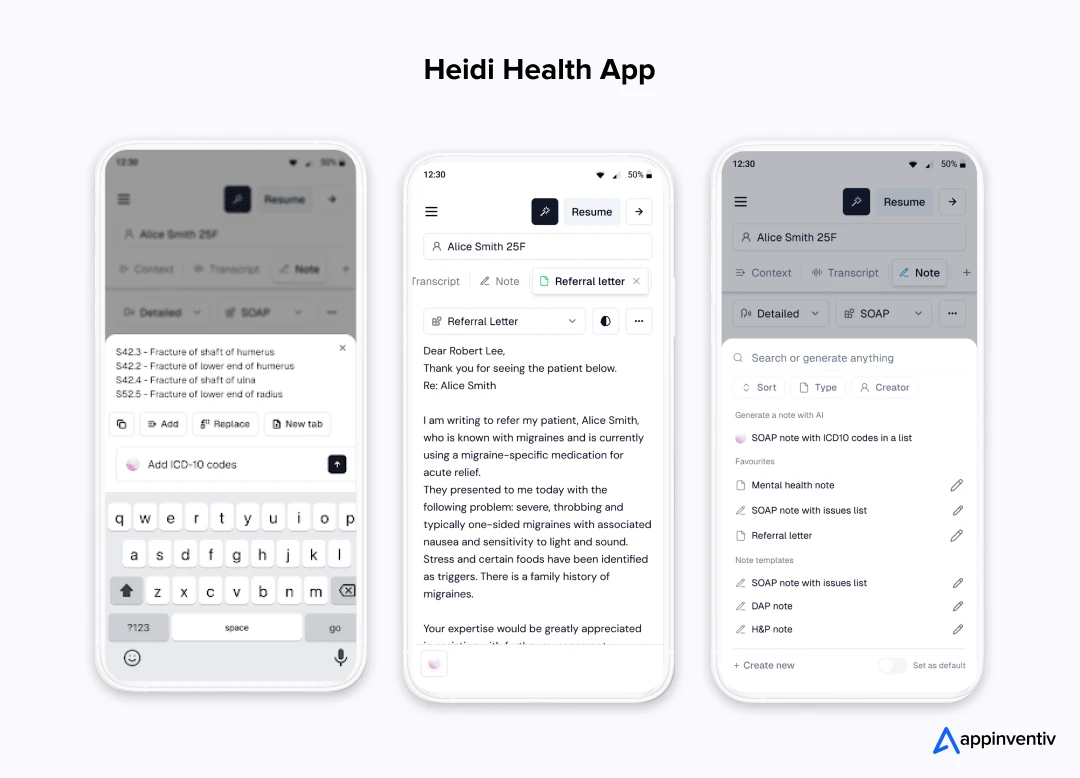
Key Takeaways from Heidi Health for Businesses Seeking to Make an AI Medical Scribe in Australia
When it comes to businesses that want to make an AI medical scribe in Australia, there are a couple of points of learning:
- Strong Core Value Proposition: Heidi Health has achieved its success by automating clinical documentation, thereby solving one of the greatest pain points experienced by healthcare professionals.
- Take a look at Advanced Features to differentiate: In addition to basic transcription, look beyond basic transcription at additional aspects like the ability to create comprehensive documents (including referral letters and patient summaries), collaborative team-based systems, multi-device support, high-level multilingual/accent transcription, and real-time billing/coding guidance, as some examples.
- User Experience and Customization: Heidi Health offers customizable templates and is built to be user-friendly, as user-friendliness is essential for clinician adoption.
- Close the Integration Gaps: Although Heidi Health has one-way EHR integration, an important alternative in a custom solution would be bi-directional integration with large number of EHR systems.
Bonus Read: AI in EHR: Complete Guide to Seamless Integration
5. Robust Compliance and HIPAA Compliance: Heidi Health emphasizes compliance. Australian context: Australian Privacy Principles (APPs) together with local data residency requirements (e.g., using servers located in Sydney) are strict requirements to be observed. This generates trust, and it will reduce medicolegal issues.
Cost to Build an AI Medical Scribe in Australia
Whether you’re a small clinic or a multi-specialty hospital, understanding the cost to develop an AI medical scribe like Heidi Health in Australia will help you make an informed decision. Read on to explore what goes into the financial planning to build an app like Heidi Health.
Cost Estimates (Based on App Complexity)
The complexity of an AI medical scribe would greatly determine the overall price of investing in it in Australia. Although the potential cost of a high-end solution ranges from AUD 68,700 to AUD 458,000 ($45,000 to $500,000), it can be divided into layers of capabilities and complexity.
| Product Name | Price Range (AUD) | Features/Functionality | Suitability |
|---|---|---|---|
| Simple AI Medical Scribe | 68,700 – 150,000 | Core transcription, simple note generation, scant customisation, basic one-way EHR development, standard security. | Individual practitioners or minor clinics with simple documentation requirements. |
| Medical Scribe AI | 300,000 – 150,000 | Increased capabilities of customization, better developed templates, simple analytics, better (though not always bilateral) EHR connections, and strong security. | Medium-sized practices or practices with slightly more varied documentation needs. |
| Complex AI Medical Scribe | 300,000 – 458,000 | Two-way EHR interface, higher depths of Natural Language Processing (NLP), sophisticated summarization and code suggestion, ownership of numerous languages and various accents. | Large healthcare organizations or organizations with highly customized and complex operations. |
Cost Estimation (Based on Development Phase)
The different stages of the development process are closely intertwined, and any decision made in one stage can either significantly increase or reduce the cost to develop an AI medical scribe like Heidi Health in Australia in the subsequent stages. That is why one should not look at the phases of development in isolation. It should be a holistic approach as strategic investment can be realized.
| Stage | Cost Range (AUD) | Key Activities |
|---|---|---|
| Strategy & Planning | 8,000 – 50,000 | Requirements gathering, user, and technical architecture, MVP scope |
| UI/UX, design, and prototype | 10,000 – 50,000 | A user flow scheme, a wireframe, a design render, and a functional prototype |
| Artificial Intelligence Model Development Training | 30,000 – 150,000 | consumption of information, labeling, choice of model, training, optimization of hyperparameters, utilization of GPUs |
| Development | 40,000 – 300,000 and up | Front-to-back and database development, API development, and security development |
| Critical Integrations | 5,000 – 150,000 and others | Integration with EHR (bi-directional), the third-party AI APIs (STT, NLP, Generative AI, etc.), and billing systems |
| Quality Control / Testing | 5,000 – 100,000 | AI functional testing, safety test, performance testing, and accuracy/bias test |
| Implementation | 3,000 – 20,000 | Application store posting, server deployment, analytics created, CI/CD pipelines |
Bonus Read: How does CI/CD save up to 20% of mobile app development time?
Cost Estimation (Based on Features)
The development of a custom AI medical scribe involves accumulating the costs of its components and assessing the complexity of the system itself. The estimated cost contributions to major features are listed below, which, when combined, contribute to the overall range of project costs. The chosen combination and level of features will ultimately determine the price.
| Feature | Cost Contribution (AUD) | Description |
|---|---|---|
| Core AI Scribing – Feature Base System | 68,700 – 150,000 | The app features basic Speech-to-Text (STT) capabilities, like Speechify, and basic Natural Language Processing (NLP) to generate simple notes, with an intuitive interface. |
| High-Level NLP & Configurable | 40,000 – 100,000 | Allows advanced summarization, customizable note formatting, and the creation of advanced medical documents. |
| Two-Way EHR Integration | 70,000 – 150,000 | It enables bi-directional, painless data transfers with Electronic Health Record systems, necessary for implementing automatic data input and output. |
| Real-time Billing and Coding Aid Feature | 50,000 – 120,000 | Uses Machine Learning (ML) to propose proper CPT and ICD-10 codes and automate the process of billing, increasing the chances of maximizing revenue. |
| Improved Security and Compliance Features | 40,000 – 80,000 | Deployment of highly secure standards, strong data encryption, and other capabilities to promote strict adherence to the standards of Australian Privacy Principles (APP) and privacy standards as given in HIPAA. |
| Multi-lingual and High-Level Accent Recognition | 30,000 – 60,000 | Enhances the AI’s ability to translate and transcribe various languages and regional accents in Australia. |
Cost Estimation (Based on Compliance & Legal Expenses)
The process of applying rigorous healthcare guidelines and navigating medicolegal factors is non-negotiable in the context of creating an AI medical scribe in Australia, which introduces substantial cost implications.
| Compliance/Legal | Details | Estimated Cost Range (AUD) | Key Consideration/Detail |
|---|---|---|---|
| General Privacy Compliance | Australian Privacy Principles (APP) | 5,000 – 12,000 annually | Compliance with the APP in the collection, use, storage, and disclosure of sensitive health information. |
| Global Benchmark | HIPAA Compliance (Global Benchmark) | Audits/Outsourcing: 80,000 – 120,000 Platform Development: 45,000 – 200,000 Risk Analysis: 2,000 – 20,000 Employee Training: 1,000 – 5,000 Technical Safeguards: 1,000 – 8,000 | Strict requirements for Protected Health Information (PHI) are in place; many Australian solutions employ a comparable level of security. |
| Medicolegal Bearings | Due Convenance and AI-Characteristic Legal Analysis | Flexibly priced; attorneys’ charges beginning at 2,000 | Not the cost of features, but the costs of mitigating risk. Encompasses informed consent, mitigation of bias, and clinician accountability. |
| Costs of Ethical Review Board | Preliminary Analysis: 990 – 1,980 (AIHW); 1,000 – 5,000 (IRBs) | 0 – 990 (AIHW); Fees to continue review and amendments (IRBs) | Necessary to create AI using health data, particularly during research or innovative clinically-based applications. |
Factors Affecting the Cost to Develop an AI Medical Scribe like Heidi Health in Australia
The development of a complex medical scribe AI requires expertise in multiple areas. Every location also incurs a significant additional cost in terms of development. The AI Medical Scribe development Cost in Australia fluctuates by various factors, including:
Design Complexity:
- Simplicity vs Richness: An easy-to-use, intuitive interface that clinicians can easily adapt to is the most important. Heidi Health is concerned with the simplicity of use. A simple, template-based UI will not cost as much as a highly customizable, interactive, and data representation-rich interface with complex data visualization tools.
Bonus Read: Guide to Use AI in Creating Dynamic & Interactive Data Visualizations
- Workflow Integration: The design of a UI/UX that seamlessly integrates into the existing clinical practice flow (e.g., a direct interface with Electronic Health Records/ EHRs) is time-consuming and expensive, but also highly critical to adoption.
- Mobile Responsiveness: Designing and devoting our time to both devices (desktop) and catering to mobile (IOS and Android applications) costs us more in terms of time and design.
- Personalization of the user: Features that involve personalization of the user, such as templates, dictation style, and output format (such as the personalized templates in Heidi Health), increase the complexity of UI/UX.
| UI/UX Design Component | Estimated Cost (AUD) |
|---|---|
| User Flow Mapping & Wireframing | 5,000 – 8,000 |
| Visual Design System Creation | 4,000 – 8,000 |
| Interactive Prototyping | 6,000 – 14,000 |
| Total for Medium Complexity | 15,000 – 30,000 |
Backend Development:
- Scalability: A High number of concurrent users and data on the backend will be generated; therefore, the backend requires robust architecture and infrastructure. These factors consider the real-time processing of audio, data storage security, and effective search.
- Data Processing Pipelines: A key component of the backend is to build effective pipelines for handling audio data, including ingestion, transcoding, transcription, natural language processing (NLP), and note generation.
- API Development: Developing APIs that are safe and effective to integrate with EHRs and any other third-party platform.
| Backend Development Component | Estimated Cost (AUD) |
|---|---|
| API Development | 8,000 – 15,000 |
| Database Architecture & Implementation | 5,000 – 12,000 |
| Authentication & Security | 7,000 – 13,000 |
| Server Setup & Configuration | 2,000 – 10,000+ |
| Total for Medium Complexity Backend | 20,000 – 50,000+ |
Backend Technology Stacks
- Languages: Python (AI/ML), Node.js, Java, and C++ are commonly used. This will affect costs due to the expertise and availability of language developers in Australia.
- Databases: The working and appropriate databases require both security and scalability (e.g., PostgreSQL, MongoDB, and MySQL). Healthcare information requires very strong security and integrity.
- Cloud Infrastructure: It is practically a given to use cloud platforms such as AWS, Google, and Azure to achieve scalability, computing power (especially when it comes to AI), and storage. This charge will be recurring, and it will depend on usage.
- AI/ML Frameworks: The usage of the AI framework, such as TensorFlow, PyTorch, or Hugging Face, to create and implement AI models.
Third-Party Integrations
- EHR/PMS Integration: This is the most important and challenging integration. Heidi Health is integrated with most of the leading Australian EHRs, including Best Practice and MedicalDirector. Integration of different EHR systems with one another is custom-developed and may be time-consuming because each EHR system has its own unique APIs and data structures. This is a big cost driver.
- Medical Billing Systems: Add-ons to billing systems that give automated code suggestions (such as the MBS Helper in mAIscribe) are very worthwhile, but expensive.
- Telehealth Platforms: A Virtual consultation that is easy to incorporate.
Bonus Read: How Much Does Telemedicine App Development Cost?
| Integration Type | Estimated Cost (AUD) |
|---|---|
| Standard API Integrations | 5,000 – 15,000 |
| Custom API Integrations | Up to 150,000 |
| EHR System Integration (general) | 10,000 – 50,000 |
Security and Compliance
- Australian Regulations: The use of Australian privacy laws (Privacy Act 1988) is applicable where sensitive health information (My Health Records Act 2012) is concerned. This will need well-configured data encryption, access control, audit logs, and data sovereignty (data is onshore in Australia).
- International Standards: Obtaining certifications, such as ISO 27001, SOC 2 Type 2, and HIPAA compliance (although not required exclusively in Australia, it contributes to security assurance), increases the costs of development and auditing.
- Penetration Testing & Vulnerability Assessment: Security testing needs to be done regularly and is an ongoing cost.
| Regulatory & Cybersecurity Cost Category | Estimated Cost (AUD) |
|---|---|
| TGA Application Fees – Class I | 550 |
| TGA Application Fees – Class IIa/b | 1,060 |
| TGA Application Fees – Class III | 1,370 |
| TGA Application Audit Fees – Level 1 | 3,990 |
| TGA Application Audit Fees – Level 2 | 7,310 |
| Annual Compliance Audits | 20,000 – 200,000 |
| Annual Cybersecurity Measures | 50,000 – 250,000 |
| Data Encryption (monthly) | 100 – 2,000 |
Bonus Read: Guide to Build a Secure App in Australia in 2025
Platform Selection
- Web-Based: A web-based platform will be highly accessible to many, but it may require special consideration for different browsers and devices.
- Mobile (iOS/Android): Native mobile apps offer better performance and user experience, but come with the disadvantage of more costly development, as they must support different devices. Heidi’s health can be found on a mobile application.
- Desktop Applications: Not very typical to scribes, and are not likely to be considered except in certain clinic arrangements.
- Hybrid Applications: They can be written once and run on multiple platforms using frameworks such as React Native or Flutter, which may be less expensive but result in a loss of native performance.
| Platform Type | Estimated Cost (AUD) |
|---|---|
| Web App Development | 40,000 – 300,000 |
| Mobile App: Simple | 25,000 – 40,000 |
| Mobile App: Mid-Level | 50,000 – 90,000 |
| Mobile App: Enterprise/Feature-rich | 100,000+ |
| Native Mobile App (approx.) | 400,000 |
| Hybrid/Cross-Platform Mobile App (approx.) | 600,000 |
| Cloud Infrastructure (annual) | 100,000 – 1,000,000 |
| On-premises Hardware (initial) | 5,000 – 100,000+ |
Advanced Technologies
- Speech-to-Text (STT): High-precision medical-level STT models are a necessity. This can be achieved by utilizing available APIs (such as Google Cloud Speech-to-Text or AWS Transcribe Medical) or custom models, but this approach is significantly more costly.
- NLP and NLU: Essential when it comes to deriving the underlying clinical entities, relationships, and context of transcribed text. It includes such techniques as named entity recognition, sentiment analysis, and summarization.
- Large Language Models (LLM): Larger training of LLM models (or fine-tuning of these models, currently demonstrated in some AI scribes, e.g., GPT-4). The fees for using these models (API usage fees) are a recurring operational cost.
- Machine Learning (ML): ML in Healthcare ensures more accurate daily note-taking, personalization of templates, and pattern detection in documentation.
| AI Model Type (Development) | Estimated Cost (AUD) |
|---|---|
| Basic ML Algorithms | 7,500 – 75,000 |
| Deep Learning Models | 45,000 – 75,000+ |
| Fine-tuning Pre-trained LLM | 7,500 – 75,000+ |
| Natural Language Processing (NLP) Development | 90,000 – 500,000 |
| Data Acquisition (per dataset) | 1,500 – 150,000+ |
| Data Cleaning/Pre-processing | 15-30% of total data cost, or 7,500 – 150,000+ |
| Data Annotation/Labeling (per label/object) | 0.045 – 4.50+ |
| Data Annotation/Labeling (per hour for annotators) | 9 – 45+ |
| Synthetic Data Generation | 15,000 – 150,000 |
Feature Complexity
- Customisable Templates: The Capacity of users to establish and customise note structures (Heidi Health provides this).
- AI Querying: Offering users the possibility to request the AI to modify notes, create specialized documents, or access general medical information (an exclusive feature of Heidi Health). This will require advanced NLU and LLM capabilities.
- Downstream Document Creation: The creation of letters of referral, patient summary, patient care plans, and their charges through the main note.
- Multilingual Support: To build an app like Heidi Health, having multilingual support can enhance your app’s value. This adds significant complexity, as provided by Heidi Health, since it requires multiple multilingual STT, NLP, and LLMs.
- Contextual Input: Enabling clinicians to provide detailed background information that helps stimulate notes generated but not spoken out loud (Context feature in Heidi Health).
- Collaboration: Multi-disciplinary shared sessions.
- Real-time versus Post-session Processing: Real-time processing requires more advanced infrastructure with low latency, and it is expensive.
- Reporting and Analytics: Efficiency, time saving, and quality of documentation dashboards.
Also Read: Guide to Understanding Data Analytics in Healthcare
Get a clear cost breakdown for your custom AI Medical Scribe App, tailored to development stages and key factors.
Process to Develop AI Medical Scribe in Australia
You must understand the process of development, as it helps you to determine the different components of AI Medical Scribe development Cost in Australia. The development of an artificial intelligence medical scribe in Australia warrants an organized process with multiple stages that take into consideration the technicalities of development, regulatory aspects, and acceptability among users.
Discovery & Feasibility study
This early stage is vital in formulating the scope, objectives, and viability of the project. It is related to the thorough market research to help define particular pain points in the Australian healthcare documentation, as well as grasp the competitive world with the available solutions, such as Heidi Health. The most important activity is to establish clear objectives of the AI scribe, the desired levels of efficiency improvement, or other clinician pain points to alleviate.
UI/UX Design and Creating a Prototype
Then, after the discovery, the UI/UX design stage is implemented to offer a user-friendly and efficient experience for Australian clinicians. This is where user flow mapping, wireframes, and the development of a visual design system are being considered, aligning with healthcare aesthetics and usability norms. Interactive prototypes are created to imitate the experience of using the product, so it is possible to test it and collect feedback from a potential user (doctors, nurses, administrative personnel) early on.
This design cycle also helps to ensure the scribe would fit organically into current clinical workflows, cause minimal friction, thus maximizing its adoption, an essential feature in preventing clinician burnout.
Bonus Read: Wireframe: Integral Part of Mobile App Development
Data preparation and model development of AI
This is where the medical AI scribe is tech. Preparation of the data is done first with great care, such as data acquisition, error and inconsistency elimination, and fine annotations by medical experts. It is a process that is labor-intensive and relatively expensive, particularly where sensitive medical data is involved.
Small steps include the selection and development of the due AI models, focusing on the main fields of Natural Language Processing (NLP) and speech-to-text features. Since training Large Language Models (LLMs) at scale is expensive, it is more financially viable and feasible to fine-tune these pre-trained parameters on aspects of medical domains using domain-specific medical information.
Backend Development Frontend Development
The backend development is undoubtedly the most crucial part of the application as it forms a secure and scalable infrastructure under which the AI model works, and all data is managed. This involves creating secure APIs to communicate, designing and developing secure databases, deploying the authentication/authorization system, and configuring the cloud servers (e.g., AWS, Azure) to perform and scale well. The most important way of ensuring that the Australian privacy laws are met is through security measures like encryption.
Frontend development is aimed at creating the UI/UX designs into a working and interactive application, for use by clinicians. This is the side where the interface the user sees is coded, whether web platform, mobile communication platform, and it is responsive, easily navigated, and can easily engage with the backend AI services.
Integration & Interoperability
The goal is to get the AI scribe able to connect with current healthcare IT systems seamlessly. This will involve the development and utilization of APIs to integrate with other available Electronic Health Records (EHR) and Practice Management Systems (PMS) frequently used in Australia, like Zedmed. The effective and secure exchange of data depends on the use of such standards as HL7 FHIR.
Quality Assurance
Quality assurance (QA) and extensive testing cannot be compromised in the case of healthcare software, where mistakes can be disastrous. This stage consists of thorough functional testing on different devices and OS, optimization of the performance to be real-time responsive, and critical testing of security to identify and address potential security breaches.
A key requirement is that a compliance test is conducted to ensure that all Australian standards (TGA, APP) and international ones (ISO, SOC) are observed. End user testing (UAT) enables the scribe to satisfy real-world clinical requirements and processes.
Deployment and Authorization
The AI medical scribe should be able to go through the Australian regulatory environment before deployment. This is done by compiling and presenting paperwork to the TGA, in particular, when the software is considered a medical device. This involves fee payment upon application and possible auditing exercises. The growing regulatory pressure of the TGA on the AI scribes implies that developers should be willing to prove their accountability, transparency, and responsibility regarding their AI model and training sets.
As soon as it gets regulatory approval, the application is put into production servers, which in most cases are in a walled cloud. This includes the provisioning of servers, configuration of production, and installation of strong monitoring systems.
Release Support and Post-Launch Support and improvement
Launches do not mark the stages of development. A persistent form of maintenance and iteration is necessary to maintain the longevity and subsequent effectiveness of an AI medical scribe. This involves routine software updates, bug and security patches to counter new threats that arise, and also compatibility with newer operating systems and EHR systems.
The models of AI must be constantly perfected and retrained on more current data to remain accurate and relevant; moreover, clinical terms and practices change. Feedback received by users helps improve features and streamline performance.
Cost Optimization Strategies
Creating an innovative AI-powered medical scribe in Australia would demand a significant investment. Yet, there are a few strategic methods to optimize the cost in Australia without compromising quality or compliance.
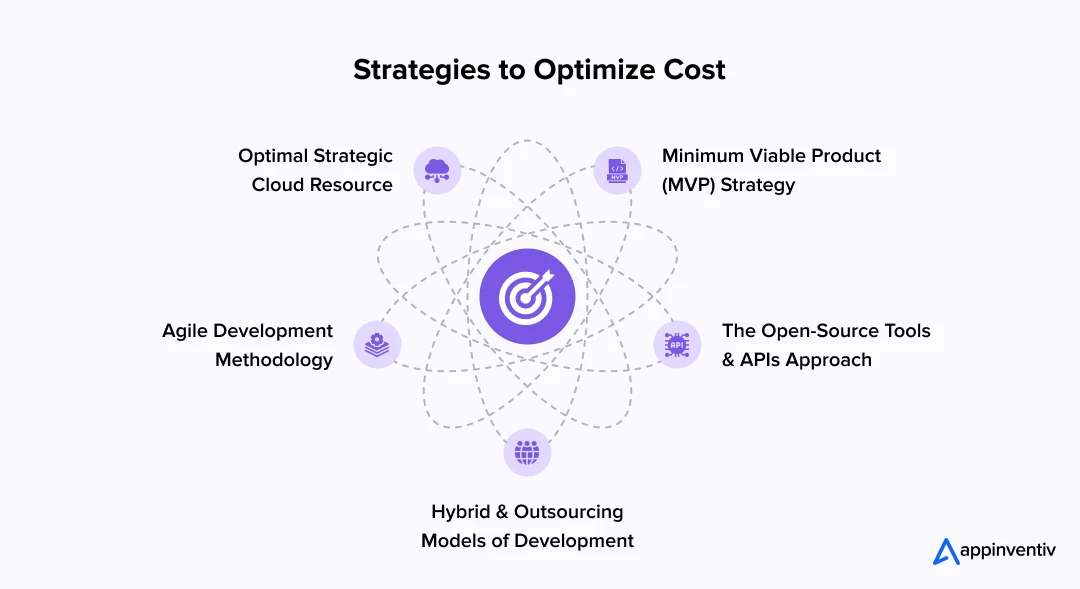
Minimum Viable Product (MVP) Strategy
The adoption of a Minimum Viable Product (MVP) strategy is one of the most effective strategies for cost optimization in the development of healthcare AI. The MVP is just a simplified version of the software, containing only the essential features, to validate the concept and gather initial user feedback.
This model lessens startup spending by an enormous measure (40-60 %) and shortens the time to market (3-6 months UK-based as compared to 12-18 months for a full product).
The Open-Source Tools and APIs Approach
The third-party APIs and the use of open-source tools can save a lot since it is not necessary to develop most of the functionalities that are provided by other third-party APIs. Rather than creating their own speech-to-text engines or components of natural language processing, developers can easily incorporate accessible services that are, in many cases, highly optimized.
As an example, commercial Speech-to-Text API services such as Azure AI Speech or Google Cloud Speech-to-Text can be provided using a pay-as-you-go model, where you will be charged per minute or hour of audio being processed. This avoids the massive initial outlay of developing and training more complex foundational models that cost tens of millions.
Agile Development Methodology
With the Agile development approach, significant cost reductions and positive healthcare software development outcomes can be achieved. Agile focuses on iterative development, creating software by small, manageable batches, which can be tested and enhanced iteratively. This is opposed to the Waterfall approach, where it is far too costly to correct errors deep into the cycle. Research indicates that Agile projects are 6 times more successful and 4 times less expensive than Waterfall projects.
Optimal Strategic Cloud Resource
Upscale utilization of the cloud infrastructure is an important consideration in cost management in the development of AI in healthcare. Scalable computing environment provided by AWS, Azure, and Google Cloud comes at a cost that can easily generate a significant bill when not optimized.
The strategies of sole optimization are:
- Matching Resources and Workload: There are ski slope workloads that do not need the most powerful or expensive hardware. The services significantly lessen the expense by selecting appropriate resources to meet the needs. When performing training on large models, training with Google Cloud TPU may lead to performance improvements at a reduced cost compared to GPUs.
- Automated Cost Visibility and Graphics: For managing costs, it is possible to automate the process of monitoring and insights on clouds (i.e., Google Cloud BigQuery, Azure Cost Management + Billing, AWS Cost Explorer). It is possible to automate these insights to identify anomalies or spikes in spending as they happen.
- Utilising Cloud-Themed Cost-saving Opportunities: All cloud providers have distinct pricing models and opportunities to reduce compute expenses, such as Savings Plans or Reserved Instances.
- Optimizing Data Storage and Transfer: Storage and data transfer fees can become expensive rapidly, especially for AI workloads that demand large quantities of data. One can also cut the costs by storing infrequently used data on the more economical cold storage tiers (e.g., AWS S3 Glacier, Azure Blob Archive, or Google Cloud Coldline); compressing and preprocessing data before storage, and using regional storage options.
Hybrid and Outsourcing Models of Development
Since recruitment of specific AI/ML engineering talent is very expensive in Australia (AUD 148,000-197,000 per year), some elements of development can be outsourced or the hybrid model adopted (that combines domestic knowledge with third-party teams).
AI features for Medical Scribe Apps for Australian Clinics/Hospitals that Out-Do Competitors
Even though Heidi Health is already providing powerful options such as adjustable voice, AI command line, and personalised note designs, the subsequent AI medical scribes will be able to combine impressive options to add even more value and outperform the current exhibition competitors in the Australian market. Such capabilities go beyond ease of documentation to active clinical assistance and heightened patient involvement.
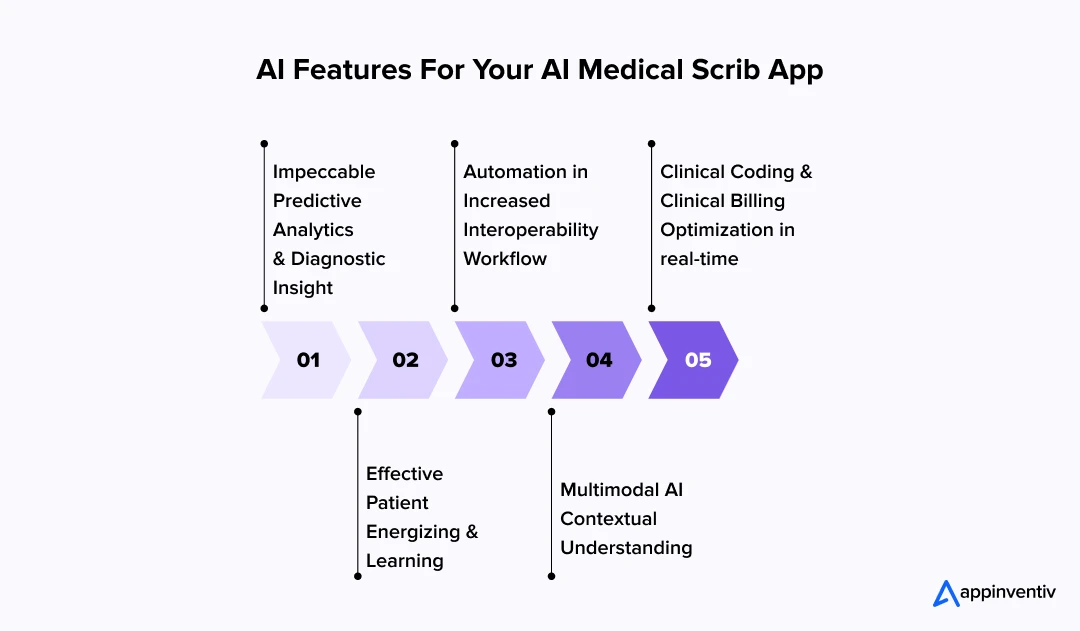
Impeccable Predictive Analytics and Diagnostic Insight
An AI medical scribe may see the future progression beyond summary note-making to providing real-time predictive analytics and assistance with diagnosis. It would entail the use of transcribed consultation data to analyze the health risks using the existing patient Electronic Health Record (EHR) data, and recommend the appropriate diagnostic tests or indicators of evolving diseases.
An example is that the system might examine the symptoms referred to during a consultation by comparing them to an immense knowledge base of medical literature and patient outcomes to give preliminary differential diagnoses or point out conditions that may be missed. This would improve the accuracy of diagnosis and maybe the cost of treating the condition.
Effective Patient Energizing and Learning
The AI scribes of the future would be capable of greatly increasing patient engagement as they could be programmed to produce individual and understandable summaries and educational resources about the patient immediately following a consultation. The AI may create a personalized after-visit summary, drug plan, or follow-up plan, which should directly reflect the particular conversation and the level of health literacy of the patient.
In addition to summaries, the AI has the potential to create educational material tailored to the patient’s diagnosis or treatment plan and present it within a secure patient portal or app.
Automation in Increased Interoperability Workflow
As Heidi goes about integrations, a super scribe would have full efficiency and smooth interoperability with a broader scope of healthcare systems, other than the EHR/PMS. This entails the integration of pathology and radiology labs’ direct result access, prescribing modules with the live monitoring of the prescription, and telehealth platforms towards an entire patient journey.
The scribe, instead of just taking notes, would be able to automate more of the rest of the administration (like writing referral letters, completing pre-authorization forms, queueing orders, and even streamlining the billing procedures with real-time proposal of accurate medical codes). Such thorough integration and automation would also lower the administrative burden and simplify clinic operations, as well as decrease the number of errors in practice, resulting in increased efficiency and cost savings for practices.
Multimodal AI Contextual Understanding
An AI scribe can take on multimodal AI features, where an advanced version would not only be voice-based but would also use visual data (e.g., medical imaging, facial expressions of the patients during consultation) or even physiological data from wearable devices. That would allow a more complex and comprehensive insight into the patient’s clinical situation. As an example, the AI may study facial expressions or body language recorded through a camera and determine levels of pain or states of emotion, which computer-driven voice-only systems could fail to notice.
The IoT device, such as continuous glucose monitors or even smart blood pressure cuffs, brought into the scribe may enable him to match the verbalized symptoms with objective physiological data, which will result in more precise and complete documentation.
Clinical Coding & Clinical Billing Optimization in real-time
One of the most advanced functions could be the on-the-fly generation of precision clinical codes (e.g., ICD-10, CPT), billing recommendations, the base of the transcribed consultation, and created notes. This would go a long way to ease administrative load related to medical billing, maximize billing accuracy in codes, and other factors that determine revenue realization by healthcare organizations.
It was possible to train the AI on the history of billing in a given practice and the preferences of clinicians to provide highly tailored and accurate advice on coding. This would not only save time but also allow the practice to meet the complexities of billing and reduce claim denials, which are directly linked with the financial health of the practice.
Supercharge diagnostics, engage patients, automate workflows, and optimize billing with cutting-edge AI.
Appinventiv: Your Proven Partner for AI Medical Scribe Innovation in Australia
Development of an AI Medical Scrib App such as Heidi Health in Australia is not a technical project, but a necessary investment in the reinvention of clinical processes and support to the patient. To ensure a successful journey through the maze of intuitive UI/UX, powerful backend systems, high levels of AI model training, and rigorous regulatory compliance, there has to be a partner with unrivaled expertise and a record of successful delivery.
And this is exactly why Appinventiv is the right choice to realize your vision. Our AI app development company in Australia is renowned for delivering results with a time-tested track record in helping businesses become digitally competitive. We have completed over 3,000 projects across various highly regulated industries with more than 1,600 well-trained professionals.
We know that the Australian healthcare ecosystem requires solutions that are not only technologically advanced but also highly compliant and easily integrated. We provide full-fledged healthcare software development services in Australia to tackle all the aspects of this problem so that a solution can be effective and impactful:
- AI Consultancy: Our involvement will begin with ensuring we have a solid purpose to move towards, clarifying the most impactful AI use cases, carefully matching the local area of clinical workflow, and developing a strategy roadmap that accurately hits what you need and what the local market needs.
- AI Solution Design: Our UI/UX designers are geniuses at designing easy-to-use and clinician-focused user interfaces. They are concerned with minimizing cognitive load and maximizing user adoption, so that your scribe fits seamlessly into usage every day, just like the responsive and customizable features highlighted as the best in top solutions.
- Strength in AI App Development: We will capitalize on our expertise in Natural Language Processing (NLP) and Machine Learning (ML) to develop the essential intelligence of your scribe. Be it adjustments to stronger pre-trained models or custom algorithms, we are strictly obsessed with accuracy, effectiveness, and the capacity to interpret the unique character of medical discussions.
- Fluid AI Integration: At the heart of what we will be doing is interoperability. Our top priorities are integration and a seamless connection between your AI scribe and the AI, namely existing Electronic Health Records (EHR) and Practice Management Systems (PMS) common in Australia. This will both remove manual work-arounds and optimize the flow of data, resulting in improved patient care and paving the way to substantial administrative efficiency.
- AI Complainces & Security: We are committed to ensuring our security and compliance, and nothing less. We develop solutions that align with the best global practice, like ISO 27001 and SOC2, and we carefully shepherd through Australia, specific regulatory practices like the Australian Privacy Principles (APPs) and the Therapeutic Goods Administration (TGA), and the ongoing definition of regulation of medical devices.
Our projects, which range from creating the YouComm Health App that helps improve patient communication to the Soniphi Vitality Health App, which monitors your health with advanced features, to the Health-e-People Health Assessment App, which offers all-in-one overall well-being, illustrate our unmatched ability to create meaningful healthcare solutions. Our developed DiabeticU Diabetes Management App is also indicative of our priority to give patients the best attention they deserve via innovative technology.
These projects, and the various industry awards, such as being named one of the Fastest Growing AI Development Companies, are testament enough to our dedication to excellence and the deliverable output that we always produce from what we do.
Join us to develop an AI medical scribe that can empower clinicians, improve patient outcomes, and establish some new benchmarks in terms of efficiency and innovation in Australian healthcare.
FAQs
Q. How much does it cost to build an AI medical scribe like Heidi Health in Australia?
A. AI Medical Scribe development Cost in Australia involves costs for development, infrastructure, and compliance. Depending on features, scale, and integrations, development costs can range from AUD 68,700 to AUD 458,000.
Q. How long does it take to develop a Heidi Health-like AI medical scribe?
A. Timeline to develop AI scribe solution is 12–24 months, depending on the scope and existing infrastructure. This includes 3–6 months for AI model training (e.g., NLP and speech recognition), 6–12 months for software development and EHR integration, and 3–6 months for testing and compliance with Australian healthcare standards. Agile development and pre-existing frameworks can shorten timelines.
Q. What are the benefits of developing an AI scribe like Heidi Health?
A. The advantages of developing an AI scribe, such as Heidi Health in healthcare are as follows:
- Medical Economics: Saves 1-2 hours per day for providers because clinical documentation is fully automated, eliminating the need to transcribe patient encounters.
- Better Accuracy: Allows 90-99% accuracy in transcription using the best-in-class NLP and speech recognition, which reduces the chances of error in clinical notes in contrast to manual transcription.
- Greater Clinician Attention: Allows the provider to be relieved of the administrative load, giving clinicians more attention to their patients, leading to increased clinical outcomes and patient satisfaction.
- Smooth EHR Integration: Performs well on the significant EHRs, Epic, Cerner, and Athenahealth, and eliminates complications with workflow and consistency of information systems.
- HIPAA Compliance: Designed with industry-standard encryption and secure cloud storage, providing patients with privacy of their data and policies, and security assuring laws such as HIPAA or PIPEDA.
Q. What’s the ROI timeline for implementing AI medical scribes in Australian practices?
A. AI scribe implementation in Australia can yield a positive ROI within 3–6 months for most Australian practices. Clinicians save 1–2 hours daily on documentation, equating to $10,000–$121,000 in recovered clinical time within 12–16 weeks, with ROIs of 5x–10x reported. Increased patient capacity and reduced burnout further enhance returns, though timelines vary by practice size and subscription costs ($99–$600/month).
Q. Mention the tech stack used in AI scribes like Heidi Health?
A. The exact tech stack for AI scribes like Heidi Health is not fully disclosed, as companies often keep proprietary details private. However, based on industry standards and available information about AI medical scribes, the tech stack typically involves the following components:
- Automatic Speech Recognition (ASR): Google Speech-to-Text, Amazon Transcribe, or open-source frameworks such as Kaldi or DeepSpeech.
- Large Language Models (LLMs): GPT-like models, BERT, or custom-trained medical models.
- Natural Language Processing (NLP): spaCy, NLTK, or Hugging Face’s Transformers.
- Cloud Infrastructure: AWS, Google Cloud, or Azure
- Frontend and Backend Frameworks: React, Angular, or Vue.js for the frontend. Node.js, Python (Django/Flask), or Java for Backend.
- EHR Integration APIs: EMR integration in AI scribes for healthcare includes – FHIR or HL7 for seamless data exchange.
Q. How do Australian privacy laws affect AI medical scribe development costs?
A. Compliances for an AI medical scribe app influence the cost to build an app like Heidi Health. Whether you are looking to develop a HIPAA/GDPR-compliant AI scribe app in Australia or planning for an AI scribe app development for clinics in Australia, securing it is crucial for you. Medical AI regulations in Australia affect the overall development budget.
For example, Australian Privacy Principles (APP) and state-specific health record laws increase development costs by requiring robust data security measures like AES-256 encryption, zero-trust architecture, and ISO 27001/SOC 2 compliance. These add 10–20% to development budgets for secure servers, penetration testing, and legal audits.
Q. How does AI scribe integration for healthcare improve workflows?
A. AI scribe integration streamlines workflows by automating real-time transcription and note generation, allowing clinicians to focus on patient interactions rather than manual documentation.


- In just 2 mins you will get a response
- Your idea is 100% protected by our Non Disclosure Agreement.

How Much Does It Cost to Build a Healthcare App in Saudi Arabia? All You Need to Know
Key takeaways: Healthcare app costs in Saudi Arabia range from 112,500 SAR to 2,250,000+ SAR based on size and complexity. The type of app you build matters more to cost than anything else. Compliance, security, and scalability are built into the cost, not add-ons. Development and testing consume the largest share of the budget. Hidden…

How Prescriptive Analytics Is Shaping the Future of Healthcare Management
A healthcare business doesn’t fall behind because its teams lack skill. It falls behind when decisions take too long. Bed allocation runs on yesterday’s data. Procurement reacts only when shortages hit. Care managers step in after a patient is already at risk. And leadership gets a picture of what’s happening only after the quarter closes,…

How to Build an Urgent Care App? A Step-by-Step Process, Features and Costs
Key takeaways: With more people turning to digital healthcare, the urgent care app market is expected to touch $3.1 billion by 2024 and continue growing fast through 2030. Apps that offer easy scheduling, video consultations, EHR access, and quick insurance handling tend to attract more users and keep them coming back. Developing an urgent care…

